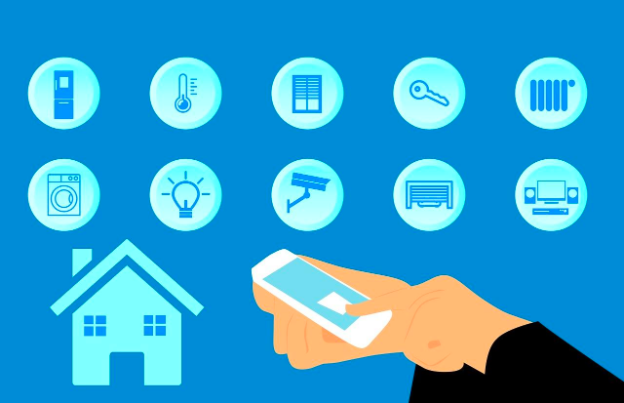Just a few years ago, controlling your lights, speakers, doorbell, windows, window blinds, right straight from your smartphone seemed like a dream that could only come to life in science fiction movies.
However, today, with the progress in the field of Internet of Things (IoT), home automation has become an everyday, household term.
With tech giants like Google (Home), Apple (Homepod) and Amazon (Alexa) investing in home automation space, software development companies have turned various ideas into reality that could be used to make life at home simpler and better.
What is Home Automation?
Home automation allows you to control the devices in your home by a smart device (such as a smartphone) with the help of a simple voice command or a push of a button. The home automation sector is slowly gaining momentum and is allowing people to do a lot of things such as controlling the home’s lighting, managing electrical appliances, operating entertainment systems, adjusting the temperature of the home and even monitoring the surveillance network.
With home automation in action, you no longer need to physically interact with devices in your home.
The ones mentioned above are just some common use cases that home automation and IoT offer. It can be utilized for several other purposes, only limited by imagination.
For instance, your home could send a notification on your smartphone once your kid gets home from school, turning the backyard lights off when sunlight is sensed or keep a directory of pictures of who visited your house when you were at work. There are a lot of gadgets in the market that help in making your life at home comfortable, safe and happy.
However, most of them work independently of one another. With home automation, the systems and gadgets still function independently but are connected to a centralized control that can be accessed from smartphones, smart speakers, computers, telephones, etc.
Let’s take a brief look at 5 smartphone apps that we think are disrupting the home automation space.
1. Nuki Smart Lock
The traditional pair of locks and keys have been around for a considerable period of time now. Also, it’s very easy for the keys getting lost or stolen.
Nuki understood this issue and came up with the concept of a smart lock that can be opened with a smartphone without the need of carrying any key.
Highlights
- The lock is well built and is very easy to set up.
- It uses end to end encryption and various other measures to make the lock as secure as possible.
- Since the lock is installed on the inside of your door, thieves cannot tell if it is there.
- If your phone runs out of juice, you can still open the door with your key.
- It works with Android, iOS, Android Wear, Apple Watch, Google Assistant and Alexa.
2. Philips Hue
Philips Hue app can be used to control its new range of Philips Hue smart lights that include the Philips Hue Light Bulbs, the Hue LightStrips, the Hue Play Color, and the Hue Bloom that can be accessed via Bluetooth and Wi-Fi.
With over 16 million colors, these lights can be dimmed or brightened remotely via the smartphone app.
Highlights:
- You can adjust the color and intensity of light bulbs to your liking. The app comes with four moods – Relax, Read, Energize and Concentrate. The colors will change from bright to soft based on the setting.
- It offers 30 built-in scenery lighting presets such as London Nightlife and Honolulu Sunset that replicates lighting from famous locations.
- You can set specific times for your lights to turn on and off.
- The lights automatically switch on when you enter your home and switch off when you leave, thanks to the geofencing feature that uses the phone’s GPS.
3. Samsung SmartThings
Samsung has been around in the field of home appliances for a long time now. SmartThings provides home automation solutions and was recently acquired by Samsung after a popular Kickstarter crowdfunding campaign.
Highlights
- You can set up different types of triggers that work with various sensors. You can activate them on a schedule, manually, or set up random activation.
- Apart from regular devices like cameras, thermostats, and locks, you can also control TVs, air conditioners and washing machines manufactured by Samsung.
- SmartThings also supports a fleet of third party products such as
- Philips Hue, Sylvania, LIFX smart bulbs
- GE, Lutron, and Leviton lighting controls
- Netgear Arlo home security cameras and Ring video doorbells
- Honeywell and Ecobee smart thermostats
- Yale, Kwikset, Schlage smart door locks
- You can even use voice commands to control your home as SmartThings supports Alexa and Google Assistant.
4. Nest
Since the launch of Nest Learning Thermostat in 2010, Nest Labs has earned a name for itself in the smart home industry.
Currently, the Nest App supports a variety of products such as Cameras, Thermostats, Smoke Alarms, Security Systems, and Doorbells.
Highlights
- You can remotely adjust the temperature of your thermostat even before you get home. Also, over a period of time, the device learns to program itself to give you the best possible heating and cooling experience.
- As long as you have an active internet connection, you can view the video feed of your house 24/7 from anywhere in the world.
- Receive an alert if the smoke detector detects an unusual amount of carbon dioxide or smoke.
5. Sonos Controller
Since its inception in 2002, the California based Sonos has strived to transform the home sound system for the digital age. Their Sonos controller app will connect to the Sonos speakers wirelessly and allow you to control them from any corner of the house.
Highlights
- It is very easy to set up and add speakers.
- Most of the major music applications such as Apple Music, Amazon Prime Music, Google Play Music, Spotify, Pandora are Soundcloud are supported by Sonos.
- You can build playlists directly from the Sonos app. So if you want to add songs from Spotify and Apple Music into a single playlist, you can.
- You can control every speaker individually.
Conclusion
IoT and Home Automation devices require a continuous transfer of data from one device to another. More the speed, lesser the latency, and better the experience. With 5G technology slowly getting momentum, the Home Automation sector is going to see a major boom. 5G will be delivered via a single protocol, making connections simpler than ever.
5G’s proposed LPWAN (low-power wide-area network) will allow all the home devices to directly connect to the internet, bypassing home networks completely. Once 5G becomes popular, home automation will become one of the most happening sectors.











